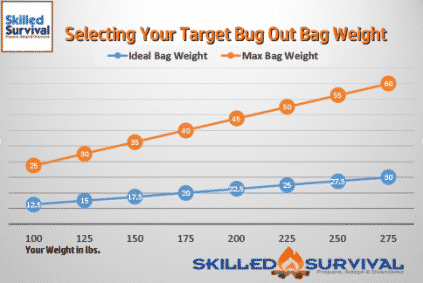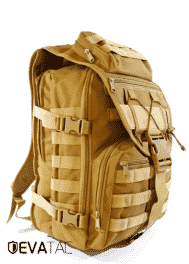
So you want the “BEST”? Well, I wish it was that easy… But I will go over everything you must know before you choose YOUR bag. And then, I will share with you what I think is THE best bug out bag on the market today.
So let’s jump right in…shall we?
TOPICS IN THIS GUIDE… ↓(click to jump)
- The Best Bug Out Bag Features
- The Purpose of a Bug Out Bag
- Making a List Of Essentials
- What’s The Best Bag Size?
- Need Plenty Of Storage Space
- Include Separate Compartments
- Lightweight and Comfortable
- Your Color Choice Matters…
- An Ultimate Pack On a Budget
- Where Are You Planning to Go?
- The Bug Out Bag I Own…
- Common Bug Out Bag Myths…
Best Bag Features To Look For
A good bag should be:
- Ridiculously durable
- Intelligently designed
- Customized to your body
Durable because you will be sorry if straps tear, zippers break, or cloth rips mid-bug out. Intelligently designed so that you can access your most critical survival gear fast.
Having the right bag size so that it won’t slow you down or wear you out due to body fatigue. Because you and your bag are about to become best friends. And nobody wants a wimpy best friend, right?
↓ My EXACT Bag Build
Purpose of a Bug Out Bag
Let’s recall what our bag is REALLY for, so we can make wise choices. It’s NOT intended to be a mini house and cannot hold all your unnecessary “Stuff.” Too much “gear” will slow you down.
When selecting your survival bag, a good rule of thumb is to decide what you need before buying the pack.
↓ 7 Reasons Why EVERYONE Needs One
Make a List Of Essentials
Before settling on a bag, figure out what you plan to put inside of it. Because it’s just a portable survival kit, right? So start with a checklist and pick and choose the gear YOU want to pack.
This can help figure out you’re overall pack size.
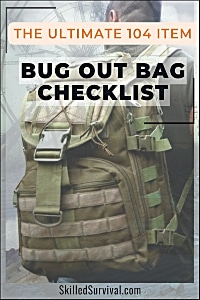
Want a free 104 item bug out bag checklist?
Enter your email below to instantly download this Complete Checklist PDF. No purchase necessary. 👇 👇- What’s your ultimate goal?
- Is it 3-day (72 hours)?
- Or do you want a full-fledged INCH bag (I‘m. Never. Coming. Home.)?
Do this before you purchase because it’s no fun to find out you don’t have enough room once you have your bag. Carefully consider which tools, gear, and survival supplies will be the most useful to YOU on the go. Your choices should be based on important factors such as:
- What survival gear do you know how to use
- Your current survival skill level
- Most likely natural disaster in your area
- What obstacles you may face
- Density population of your county
Also, remember that your initial checklist of items may change over time as you acquire more survival skills. However, don’t let that keep you from doing this worthwhile planning today.
So What’s The Best Size?
The proper bag size is based on your torso size. Measure yourself from your neck to your hipbone. Some manufacturers sell bags specifically for men, women, and children to make it easier to find the right torso size.
The bottom line is: Your bag must fit comfortably on your hips.
Here are some basic torso size guidelines to help (always double-check these figures with the bag manufacturer before purchasing):
- Extra small (for torsos up to 15 1/2 inches)
- Small (for torsos from 16 inches to 17 1/2 inches)
- Medium (for torsos from 18 inches to 19 1/2 inches)
- Large (for torsos 20 inches and up)
Plenty Of Storage Space
Backpack storage space is usually measured in cubic inches of space. The higher the number, the more volume you have for all your gear. Of course, you’ll want one with plenty of storage space for all your stuff. And some extra storage space is typically not bad as long as you don’t feel the need to fill every space just because “it’s there.”
Having a little bit of extra space helps with future expansion and gear swaps. But again watch the overall weight!
↓ 10 Tips To Reduce Your Bag Weight
Include Separate Compartments
The best designs includes several zippers, pouches, and other visible and hidden storage options. Unlike a duffel bag, this bag shouldn’t be randomly stuffed as full as possible.
In real-world survival situations, you won’t have time to dump all your supplies out on the ground to find what you need. Instead, look for a bag with lots of separate compartments for food, clothes, and gear.
That way, you’ll have easy access those items. The more zippers, loops, pockets, and straps your bag has, the more organized it will be when you need to find something fast.
If you decide bigger is better and opt for a larger bag, you’ll be able to fit a ton of stuff, don’t forget that you’ll have to carry all that gear. A good pack will typically have the following design components:
- Compression Straps
- Sternum Strap
- Top Lid
- Hydration Bladder Pouch and Tube Port
- MOLLE System
- Hip Belt & Hip Belt Pockets
- Water Bottle Pocket
- Dedicated Sleeping Pad Straps
- Internal Frame
↓ Everything You Need To Know About MOLLE
Lightweight and Comfortable
Advanced military bags include very large capacities. But there’s no point in that unless you’re preparing for a military-style bug out (think lots of guns and ammo).
Most military personnel are trained to carry bags weighing upwards of 70 pounds on their backs for many miles. If you don’t have this type of training, you’ll want to keep your bag lightweight and comfortable. Honestly, hauling a heavy load could get you killed.
It’s easy to think of many life-threatening scenarios if your bag slows you down. If you’re unsure how much weight you can comfortably carry, take your bag on a hike or camping trip. I made a chart to show you how much your bag should weigh fully loaded based on your size.
Keep adding items until you reach a point where more weight will significantly slow you down and make walking difficult (starting to get the hint?…weight matters).
Backpack Color
You’ll want to avoid bright colors and other features attracting unwanted attention. Stick with neutral/muted colors to blend in with your surroundings. Consider a camouflage bag if you live in a rural wooded area.
If you’re in a crowded urban area, get a gray man bag that looks like an ordinary backpack. The less conspicuous, the better.

Want a free 104 item bug out bag checklist?
Enter your email below to instantly download this Complete Checklist PDF. No purchase necessary. 👇 👇An Ultimate Pack On a Budget
If you into emergency preparedness but can’t afford a large bag with all the bells and whistles, then what? Some smaller more affordable bags can be found with a MOLLE (Modular Lightweight Load-carrying Equipment) system.
Purchase a smaller, more affordable pack with MOLLE and pack it with the bare essentials mentioned above. The latest generation MOLLE is made out of laser-cut cloth to eliminate stitching that may compromise the bag’s integrity. The point of MOLLE is that you can hang gear from the outside of the bag instead of packing everything inside.
You place the items you’ll need most on the outside of your bag with this system. This type of bag is an ideal choice if you’re on a budget, but you still want the ability to add easily attachable pouches over time.
Items you might want to hang from MOLLE are:
- Survival Knives
- Ammo Pouches
- Canteen Pouch
- Radio Pouch
- Medical Pouch
- Small Axe
- First Aid Kit
The options are truly endless.
Where Are You Planning to Go?
One often overlooked aspect of bugging out is…where are you headed? You need a plan; you need a location. If you have a location sorted out already…kudos to you. If your safe spot is your Dad’s house about an hour away, a very small survival go bag will work.
However, if you have many miles and a few nights to bare, then it’s better to have space for more “just in case” stuff. And you’ll want a military-grade tactical backpack.

Want a free 104 item bug out bag checklist?
Enter your email below to instantly download this Complete Checklist PDF. No purchase necessary. 👇 👇The One I Own…
It’s time to share what I believe is the best ones available on the market today.
The Combat Bag From EVATAC (top recommendation)

It’s made from 600D polyester and has durable zippers, padded shoulder straps, a chest strap, and enough compartments to organize your survival gear properly.
This bag includes a generous 40L storage capacity.
It is the perfect size to fit all your gear yet small enough for everyday use. It’s made from thick, durable 600D Polyester.
It comes with heavy-duty clips and zippers because your bag is only as good as its zippers and clips.
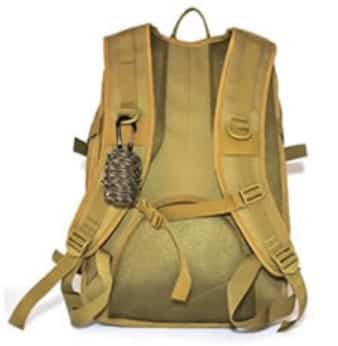
It has a quick lock chest strap to keep the bag secure even when running or scrambling.
This prevents the bag from bouncing off your shoulders while on the move!
All compartments are waterproof, which is a must-have feature for high-quality tactical bug-out bags.
It includes a total of ten separate carry compartments for maximum organization! Heck, it even has a padded laptop section to keep your fragile items safe and secure from bumps and knocks for everyday use.
Similar bags with all these features sell for over $159 (some as much as $229 in many outdoor specialty stores). But when this post was published, you could get The Combat Bag From EVATAC at a fraction of those lofty prices.
Click here to see if this amazing deal is still available on this excellent bug-out bag. Interested? Check out my full review of The Combat Bag from EVATAC:
↓ The Combat Bag by EVATAC
Interested in this bag? Click here to check out the affordable price of this quality bag.
Dispelling The 5 Most Common Bug Out Bag Myths…
Myth #1: Bigger Is Always Better
Now, it’s tempting to pack everything but the kitchen sink. But bigger ain’t always better.
The truth is: You’ve got to balance the size and weight with what you can realistically carry for long distances.
A 100-pound bug out bag won’t do you good if you’re huffing and puffing after the first mile.
Keep it lean and mean!
Myth #2: You Can Rely on Hunting and Foraging
Some folks think they can just grab their bag and go live off the land… But let’s get real – hunting and foraging ain’t as easy as it looks on TV. It takes skills, knowledge, and often a heck of a lot of time.
Your plan should include food and water supplies to sustain you until… At least until you can figure out the whole hunting and foraging thing.
Myth #3: You Can DIY Your Bag on the Cheap
We all love a good DIY project. But when it comes to your bug out bag, skimping on quality gear is a recipe for disaster.
Cheap gear can fail when you need it most. And that’s a gamble you don’t want to take.
Invest in high-quality gear and do your research. You want gear that’s built to last, not something that’ll fall apart on the trail.
Myth #4: You Can Wing It When the Time Comes
Some folks think they can just grab their bug out bag and figure things out as they go. Winging it is a surefire way to end up in a world of hurt. You need a well-thought-out plan, routes, and destination in mind.
Waiting until the last minute is a recipe for chaos and confusion.
Myth #5: Your Bag Is a One-and-Done Deal
Your bug out bag ain’t set-it-and-forget-it. You’ve got to regularly check and update your gear. Swap out expired food and water, and make sure everything is in good working order.
The last thing you want is to grab your bag in an emergency only to find out that your batteries are dead or your gear has rusted away.

Prepare, Adapt & Overcome,
P.s. - I just found out 2 out of 3 Americans don’t feel prepared for a 3 day disaster!!!
I guess this goes to show how modern society continues to embrace ‘living a fragile life.’ What’s crazy is… it’s so easy to fix.
To make sure YOU have the basics, watch our FREE training on “10 Simple Steps To Basic Preparedness” that shows you HOW.
Nothing crazy here… this isn’t doomsday prepping... just the basics every responsible adult should have before a disaster strikes.Why You Can Trust Skilled Survival...
Go here now to review a full breakdown of:
- Who We Are
- Our Credentials
- Our Mission
- & Product Recommendations...
Here are a few highlights of our teams credentials & certifications:
- Certified Member of a Mountain Search & Rescue Organization
- Plant Emergency & Safety Leader for a Major Food Manufacturer
- Member of the 10TH Mountain Division Hut Association
- Certifications: Avalanche 1, WFR, CPR
- Official Gear Tester for Numerous Outdoor Gear Companies
- Countless Multiday Backpacking trips into Remote Wilderness
- Bachelor's Degree In Mechanical Engineering
- Bachelor's Degree In Civil Engineering
- Bachelor's Degree In Biomedical Engineering
"It takes 20 years to build a reputation and five minutes to ruin it." - Warren Buffett
We're fully aware that trust is NOT something you GET but is EARNED.
And we'll continue to earn YOUR trust through our forthright and honest approach with each new Blog Post, Guide & Product we create...
P.s - I just took this FREE 60-second 'Readiness Score Quiz'👇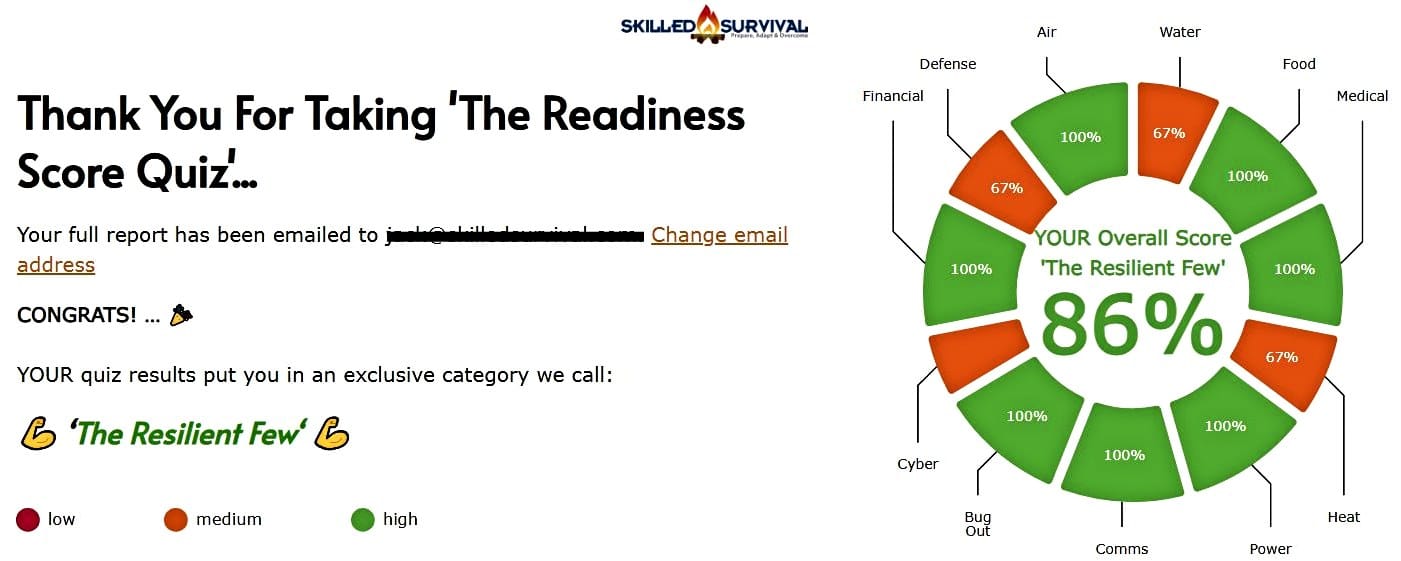
AND... I've still got a few gaps in my preps...🤔 But at least, I'm not part of 'The Fragile Masses'. 👍 Find out where YOU stand by answering a few questions...
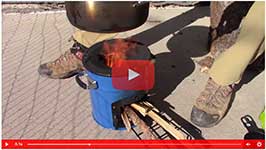
Recommended Reading
Bug Out Bag Weight: How To Reduce Every Deadly Pound
Advanced tactics to reduce your bug out bag weight because a heavy bug out pack will slow you down. And a slow getaway can get you killed.
Bug Out Location: How To Find One You Can Afford
There are 7 must-have qualities for a perfect bug out location . I show exactly what they are and how to find an affordable one in minutes...
Bug Out Vehicle: The Best Rigs To Escape The Chaos
A good bug out vehicle will help you make it out of chao to safety FAST. I show you the best options and capabilities to design your own rig.
Bug In Vs Bug Out? Smart Or Guaranteed Death Trap
One of the hardest SHTF decisions is: Bug In vs Bug Out. You should plan for both because there some situations where you may have to leave.
Bug Out Bike: THE Most Reliable Way To Escape
A simple 6 step action plan to turn a regular bike into a badass, terrain crushing bug out bike - to escape the chaos without traffic jams.
Best Survival Retreat: How To Secure Your Own Safe Haven
Building your own survival retreat is easier and more affordable than you think. Log cabins, dug outs, adobe huts are all great options.


